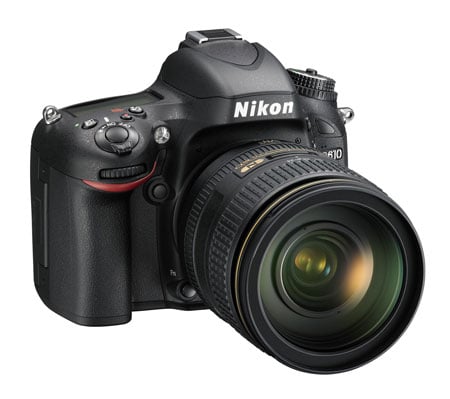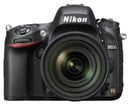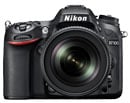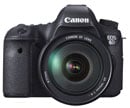Nikon D610 review
-
-
Written by Gordon Laing
Verdict
The D610 replaces the year-old D600 as Nikon’s ‘affordable’ full-frame DSLR. Positioned between the mid-range D7100 and full-frame D800, it’s aimed at upgraders from mid-range APS-C models and those looking for an economically priced full-frame back-up.
The D610 offers a handful of minor improvements over its predecessor including enhanced auto white balance, slightly faster continuous shooting and a new 3fps Continuous quiet mode. It would also appear that the well-documented issues with oil and dust on the sensor have been addressed.
The D610 is in a pivotal position in the Nikon line-up. In one sense it’s a pared back verson of the D800, in another it’s an upscaled version of the D7100, in terms of sensor size at least. One thing’s for certain: like its predecessor, it will continue to be an attractive proposition for both existing D800 and D4 owners looking for a back-up body as well as for aspiring amateurs for whom it brings full frame digital photography just about within reach.
The D610’s 24.2 Megapixel sensor falls well short of the D800’s monster 36 Megapixel resolution but, with Canon’s EOS 5D Mark III at 22.3 Megapixels and the more affordable EOS 6D at 20.2 Megapixels there isn’t another full frame DSLR that can beat it on resolution. Though if you’re in the market for a high resolution full frame mirrorless body there’s now also Sony’s 36 Megapixel A7r to consider, as well as the cheaper A7 which undercuts the DSLRs to become the most affordable new full-frame camera around.
So, while there’s not a great deal new on offer, the D610 essentially provides the same proposition as the D600 it replaces. It lacks the build quality, 36 Megapixel resolution, 51-point AF, USB 3, and 1/8000 shutter speed of the D800, but matches it for just about everything else, providing a reliable, economic back up option as well as a very attractive upgrade path.

Nikon D610 vs Nikon D600

The closest camera to the D610 is of course its predecessor, the D600. The only differences are that the new D610 sports enhanced auto white balance, slightly faster continuous shooting (6 vs 5.5fps) and a new 3fps Continuous quiet mode. It would also appear that the well-documented issues with oil and dust on the sensor have been addressed, at least from anecdotal reports from hire companies like Lens Rentals which have had a number of units pass through without complaint.
Obviously no-one who owns a D600 is likely to ‘upgrade’ to a D610, but what about someone who owns neither? Is it worth going for the earlier model instead? I’d certainly say if you can get it at a cheaper price with a good returns policy in case the oil or dust issue arises on your sample, then it would make sense as the upgrades on the D610 are pretty minor.
Indeed going for the older D600 sounds like a no-brainer, but remember camera prices are very much affected by volume, not to mention manufacturer and store discounting. It could be that the D600 is initially sold cheaper than the D610, but as the market settles and there’s more of the new version around the prices may equalise or even switch around. The bottom line is to keep a close eye on the prices and to snap up a bargain if you see one.
You can find out more about the D600 in my Nikon D600 review, which also includes quality comparisons against the higher-end D800 which still still apply to the new D610.
Nikon D610 vs Nikon D7100

Nikon’s official line is that the D7100 slots between the D7000 and D610 in the range and describes the new model as being the best that the DX format can offer. While the D610 obviously enjoys the benefits of a bigger sensor, there are compelling features the D7100 has in its favour.
But first, there’s a number of things both have in common, including 24 Megapixel resolution, 100% viewfinder coverage, 3.2in screens, 1080p movie modes at 24, 25 and 30p, microphone and headphone jacks, and twin SD card slots. Now for the differences.
The D7100 may be positioned below the D610, but enjoys a more sophisticated AF system with 51 points and 15 cross-type sensors compared to 39 points and nine cross-type sensors. Switch the D7100 to its 1.3x crop mode and these 51 points also virtually fill the frame, making it great for tracking erratic subjects right up to the edges and into the corners. With the improvements in the D610’s continuous shooting, both models are now fairly evenly matched. The D7100 enjoys a faster maximum shutter speed of 1/8000 and flash sync of 1/250 compared to 1/4000 and 1/200 on the D610. The D7100 additionally features deeper bracketing with up to five frames 3EV apart compared to three frames up to 2EV apart. In terms of build quality, the D7100 sports better weather sealing and also has a brighter screen and built-in stereo microphones in addition to being a bit smaller and around 100g lighter. Finally the D7100 costs comfortably less than the D610.
The D610 is all about the benefits of having a bigger full-frame sensor; the larger pixel pitch should mean lower noise and higher dynamic range in the D610’s favour. It also means having a much larger image through the viewfinder along with no field or depth-of-field reduction factor on lenses. This is, however, the only major benefit the D610 has over the D7100, so let’s look closer at the implications of the bigger sensor. You’d assume the D610 would deliver superior image quality to the D7100, but while this is the case at higher sensitivities, at lower ISOs the D7100 can actually match the D610’s output or even beat it, especially for out-of-camera JPEGs.
There’s also the field and depth-of-field reduction to consider as the argument between FX and DX actually works both ways. The full-frame D610 may enjoy a lack of crop factor and a big viewfinder image, but anyone shooting small or distant subjects may prefer the DX crop; some may also prefer the larger inherent depth-of-field. If you currently have a collection of DX lenses, it’s also nice to use them with 24 Megapixels on the D7100, whereas the D610 works at more than half the resolution when applying the DX crop. Then there’s that price factor again.
For some the lure of full-frame will be enough to tip them towards the D610, but if you’re making that decision on the grounds of image quality alone, it’s not as clear cut as you might think, and the D7100 remains a compelling option.
See my Nikon D7100 review for more details.
Nikon D610 vs Canon EOS 6D

The battle between the Nikon D610 and the Canon EOS 6D is an important one for both companies because it’s an opportunity for each to poach customers from the other – or to lose them. If you ignore the presence of mirrorless compact system cameras, the logical upgrade path for owners of APS-C bodies is to go for an affordable full frame model. But if, like many consumer DSLR owners, you haven’t invested in additional lenses it’s an easy matter to switch allegiances. So with the D610 Nikon is looking not only to keep its existing customers in the fold, but to attract Canon ones into it too. Canon is doing the exact same with the 6D and both are fighting hard because the newly created ‘affordable’ full-frame DSLR market they’ve created between them is very open.
So how do they stack up? The obvious place to start is the sensor. Nikon’s 24.3 Megapixel sensor has a slightly higher resolution than the 20.2 Megapixel sensor in the 6D, but the quality from these two sensors is pretty evenly matched, see my Canon EOS 6D review for comparisons. Perhaps more importantly, the D610 offers a DX format crop mode which allows you to continue using any DX lenses you may own at a reduced 10.5 Megapixel resolution. That’s likely to be a significant factor for existing Nikon owners looking to upgrade. Canon EOS 6D users upgrading from an APS-C body aren’t so fortunate as EF-S lenses aren’t compatible with any full frame Canon body, including the 6D.
Next to resolution, the factor that will likely influence many buyers is the respective AF systems, but I reckon this is something of a red herring. On the face of it, the Nikon D610’s 39-point AF system with 9 cross-type sensors is more sophisticated and capable than the 6D’s 11-point AF system which has only one central cross-type sensor. The D610’s additional sensors may cover a larger area, be more configurable and better at tracking small moving subjects, but that’s only half the story. The Canon EOS 6D’s AF system is sensitive at much lower light levels, meaning you can continue to use AF until it’s almost dark. So for shooting in very low light, for example in the late evening and at night, the 6D wins out.
A larger brighter viewfinder is one of the advantages a full-frame DSLR offers and although the EOS 6D’s viewfinder doesn’t offer full 100 percent coverage like the D610 the difference is negligible and a side-by-side comparison doesn’t reveal any significant differences between them. What is different is that the D610 allows you to turn off the AF point overlay and add a grid if you want it. At 3.2 inches diagonally, the D610’s LCD screen is also slightly larger than the 3 inch screen of the 6D and shares similar resolution, but the different aspect ratios mean the active image on the 6D is actually a little bigger.
Both models share similar continuous shooting capabilities, the D610 is slighter faster at 6fps than the 6D at 4.5fps, but the Canon can shoot Large fine JPEGs indefinitely where the D610 is limited, if that’s the word, to a 100-frame burst. Switch to RAW shooting and the Canon manages 21 frames before filling the buffer by comparison with 15 for the D610.
It’s interesting to note that the D610 provides more or less the exact same movie modes as the Canon EOS 6D which also offers 24, 25 and 30 fps recording at 1080p resolutions with 720p at 50 and 60 fps, all encoded using H.264, although the 6D also offers the choice of inter or intra-frame compression. The 6D has an socket for an external microphone, but no headphone socket. On balance I think that with its DX crop mode, uncompressed HDMI output and headphone socket, the D610 is a more capable movie camera then the 6D. At this level at least, Nikon has reversed Canon’s long held dominance in this area.
The D610 has a number of other features that the 6D lacks including a built-in flash, twin SD card slots (versus only one on the 6D), interval timer and a shutter durability of 150 thousand actuations – 50 percent more than the 6D. But not everything is in the D610’s favour. The 6D’s trump cards are it’s built-in WiFi and GPS capabilities, if you want those features on the D610, you’ll have to pay extra for the accessories and put up with the inconvenience of having them plugged in with the flap open. On top of that, the Wu-1A wi-fi accessory I tested on the D5200, or indeed the built-in wi-fi of the D5300, (which is exactly the same) didn’t offer anything like the same level of functionality as the 6D’s built-in feature and the smartphone remote control app was basic by comparison with Canon’s.
So on paper the balance looks strongly weighted in favour of the D610, but in practice the EOS 6D has a lot to recommend it, particuarly if you put yourself in the group that Canon says it’s aimed at – travel, portrait and landscape photographers. As always, you’ll need to decide which model, on balance, offers the range of features that’s best suited to the kind of photography you do.
See my Canon EOS 6D review for more details.
Nikon D610 vs Sony Alpha A7

Until recently the most common way to enjoy full-frame sensors was in a DSLR. Leica may have offered a mirrorless full-frame option with its M series and Sony a full-frame fixed lens compact with its RX1(r), but both were expensive and specialist options. However in late 2013, Sony announced not one but two full-frame mirrorless system cameras, with the cheaper Alpha A7 actually under-cutting the Nikon D610’s price while matching or even beating it in a number of respects. Both share full-frame sensors with 24 Megapixel resolution, large viewfinders with 100% coverage, mic and headphone jacks.
Their biggest difference is their form factor, and I’m deliberately not describing one as having an overall advantage over the other as it really boils down to a personal choice. As a traditional DSLR the Nikon D610 is much larger and heavier than the Alpha A7, but while it’s clearly not as portable, it gives you more to hold onto and is easier to hold steady. Both cameras share viewfinders with approximately 100% coverage and roughly similar-sized images through them too, but the A7’s image is electronic whereas the D610’s is optical. There’s pros and cons to both: an optical viewfinder is easier to use in very low light, never gets noisy and never lags as you pan to follow the action. In contrast an electronic viewfinder can offer a wealth of shooting aids including a choice of guides, a live histogram, leveling gauge, magnified views and focus peaking, and can also be used to compose movies along with navigating menus and images in playback. Only you can decide which form factor and viewfinder technology is best for you.
In terms of benefits, the Nikon D610 boasts faster single AF that works in slightly lower light (-1EV vs 0EV) and much more effective continuous AF when shooting stills with the viewfinder, twin memory card slots, a battery that lasts for more than twice as many shots (so long as you compose with the viewfinder, not the screen), a slightly larger 3.2in screen (albeit with native 3:2 images letterboxed), slightly quicker continuous shooting (6fps vs 5fps), a DX crop for movies offering a magnified view without loss of quality, a more discreet sounding shutter, and native access to a very broad lens catalogue.
In the Alpha A7’s favour, it can exploit a wealth of third party lenses without a crop (albeit sometimes with the loss of AF), it has a screen which can tilt vertically for easier composition at high and low angles, built-in Wifi and NFC for wireless transfer of images, smartphone remote control, a faster 1/8000 shutter, slightly superior video quality, supports optional downloadable apps to expand its capabilities, offers 1080p video at 60p (versus a maximum of 30p on the Nikon), the chance to top-up or recharge a battery over USB, cleaner Live View magnified focusing, focus peaking, a panorama mode, and 4k output for TV slideshows over HDMI. The A7 is also cheaper, especially in a kit.
In terms of body price, the Alpha A7 undercuts the D610, and that’s before it’s even had a chance to be discounted. If you’re buying a kit zoom to go with either body, Sony’s 28-70mm is also cheaper than Nikon’s full-frame options, further widening the price gap between them.
While the Sony, especially in the zoom kit, works out cheaper, I think the real decision boils down to which form factor you prefer and how you’ll intend to use either camera. If you intend to shoot any kind of action, the phase-detect AF system in the D610’s viewfinder is still superior at tracking to the A7. But if you’re shooting mostly static subjects, especially in Live View, then the A7 has definite handling and performance benefits, not to mention being smaller, lighter and cheaper.
For more details, check out my Sony A7 review and if you prefer the sound of its higher resolution sibling, check out my Sony A7r review!
Nikon D610 final verdict
Essentially, the D610 lays to rest some questions over the earlier D600’s susceptibility to sensor contamination and adds a couple of quite minor updates. That’ll reassure those enthusiasts and keen Nikon watchers who were biding their time, but my bet is a large number of people will remain unaware of these changes. In some ways the D610 updates are less relevant than the introduction of the D7100 in April 2013, which significantly closes the gap between the two models.
Despite that, the D610 continues to successfully fulfil its dual role. On the one hand as an ‘entry level’ full frame DSLR designed to appeal to enthusiast photographers looking for the kind of build, image quality and features provided by pro DSLRs at a more affordable price. On the other, a pro model backup, able to tick the same boxes as high end models like the D800 and D4, without being so good it begins to look like an attractively priced replacement rather than a supplement.
Features you’d expect to be casualties of the drive for reduced costs – the viewfinder, twin card slots, mic and headphone sockets, uncompressed video out, and weather sealing – have all survived intact. This makes it a very attractive proposition both to pros looking for a backup body and all those who’ve been patiently waiting for their first opportunity to shoot with a full-frame DSLR.
For the latter camp, the ability to continue to use their DX lenses in a cropped-frame 10.5 Megapixel mode until they can afford to replace them only sweetens the deal. As does the opportunity to use older non-AF-S lenses with the ability to autofocus. It all looks like great news for Nikon users. The D610 shares all the attributes of its short-lived predecessor, it’s is a class act and a tough one to beat. So it will come as no surprise that it gets the Cameralabs Highly Recommended award. But Nikon and Canon have to be careful as there’s now a more affordable way to enjoy full-frame quality in a smaller and lighter package to boot: Sony’s A7 looks set to shake up the market and if you’re not wedded to an optical viewfinder or action photography, this new mirrorless camera could be a better bet than either the D610 or EOS 6D.
Good points
24.3 Megapixel FX CMOS sensor.
39-point AF with 9 cross-type sensors.
6fps full-frame continuous shooting.
Compatible with DX lenses.
1080p30 and uncompressed HDMI out.
Built-in AF motor for non AF-S lenses.
Sensor contamination fixed (anecdotal).
Bad points
Resolution drops to 10.5 MPix with DX lenses.
No exposure control during movie recording.
Bracketing limited to 3 frames.
Wifi and GPS are separate accessories.




